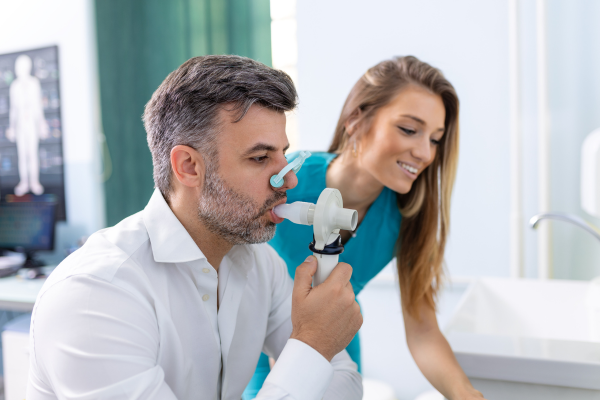Some will find that an independent exercise program is not for them. Instead, your physician may recommend a pulmonary rehabilitation program. It is important to note that this type program may not be available in all geographic locations. A pulmonary rehabilitation program is indicated for the individual who has not participated in a regular exercise program, or for someone who is having a great deal of difficulty performing activities of daily living at home and work due to breathlessness and fatigue.
A pulmonary rehabilitation program is a structured program with facilities that can often look much like a regular gym but with a significant difference in the type of staff. Pulmonary rehabilitation programs can provide you with nurses, physicians, physical therapists, respiratory care practitioners, personal trainers, coaches, teammates and others to help you achieve your activity goals.
Referral to a pulmonary rehabilitation program will assist in starting, re-starting, or upgrading your exercise program.
NOTE: Speak with your healthcare provider before starting any new exercise routine to make sure that it is safe and appropriate for you.
“How Do I Choose a Program?”
Your healthcare providers may have a program that they work with on a regular basis. If not, you may locate a pulmonary rehabilitation program by contacting local hospitals and clinics in your area. Do not be afraid to call and arrange a visit with the clinic to determine if the equipment and staff understands your needs and medical problems. Cardiac rehabilitation programs are more common in some regions than pulmonary rehabilitation programs, but they may not understand the management of your pulmonary problem as well. In selecting a program, there are some considerations that you will need to keep in mind.
Medical Animation Copyright © 2025 Nucleus Medical Media. All rights reserved.
Components of a Pulmonary Rehabilitation Program
A pulmonary rehabilitation program has three basic elements:
1. Evaluation or assessment of your current functional ability.
2. Development of a goal-oriented treatment plan specific to your defined limitations and needs.
3. Implementation of the treatment plan.
The Assessment
A formal pulmonary rehabilitation team assessment includes evaluations of muscle strength and endurance, functional task tolerance, and cardiopulmonary exercise tolerance. Physical therapists, occupational therapists, exercise specialists, and recreational therapists typically perform these evaluations. Special consideration will be given to oxygen therapy needs during exercise and other health conditions.
Your physical assessment will include a review of posture, muscle strength, muscle endurance, balance, ambulation patterns, joint stability, and cardiopulmonary endurance. It is important to assess all areas in order to design a specific exercise program that addresses your individual needs. The cardiopulmonary endurance evaluation can be accomplished by completing a sub-maximal stationary bicycle or treadmill test, a 6-minute walk test, or a 12-minute walk test.
When available to the rehabilitation staff, the results of a formal maximal exercise test can also be used to determine a starting point for training. While you are being tested, the evaluator will be measuring heart rate, blood pressure, perceived breathlessness, perceived exertion, and oxygen saturation. When indicated, cardiac monitoring may be included. As you continue with your prescribed exercise program, re-evaluations to determine your progress will utilize the same tests and measures.
A functional task assessment, based on activities of daily living, is usually performed by an occupational therapist. Activities that might be assessed include dressing, bathing, meal preparation, eating, social activities, household tasks (laundry, cleaning), and work tasks. Utilizing a Functional Independence Measure (FIM) scoring system, you define the degree of assistance required to complete tasks. When addressing self-defined limitations experienced at work, a number of standardized evaluation tools that address worker productivity and tolerance to specific work demands, such as lifting capacity, standing, kneeling, and other postures, are available.
A major factor during the assessment process is your personal goal and motivations. Your personal motivations and exercise preference will assist the care team in selecting and designing the exercise regime that will work for you.
A formal pulmonary rehabilitation team assessment includes evaluations of muscle strength and endurance, functional task tolerance, and cardiopulmonary exercise tolerance.
Advantages of a Pulmonary Rehabilitation Program
There are a number of benefits to participating in a pulmonary rehabilitation program that you may not experience if you simply perform your fitness program at home. The pulmonary rehabilitation staff can monitor how you are performing your exercises and can offer tips for improving how safely and effectively you are exercising. In addition, you can receive support from other people in the program who have medical conditions similar to your own. This can be particularly encouraging if you are wondering if you are doing your exercises correctly, and are improving fast enough.
If you do not have access to a formal pulmonary rehabilitation program, consider asking your healthcare provider to give you some advice about how you can safely perform your exercises. Make note of this advice and consider asking a personal trainer or a family member to watch you perform your exercises, to observe how well you are following recommendations. There are also online resources for pulmonary rehabilitation on YouTube. Just search for “pulmonary rehab YouTube” on your internet browser and you will see links to many videos that might help you better understand the objectives of pulmonary rehabilitation and some exercises with demonstration. Look for videos done by a healthcare center or university. If you have Medicare, many supplements to Medicare Part B and Advantage plans include a gym membership for free. One example of a membership is “Silver Sneakers”, https://www.silversneakers.com/.
In any event, whether or not you start your fitness program at a rehabilitation center, you will want to continue prescribed activities at home, because maintaining your fitness is a life-long activity. With time, you should see measurable improvement in your ability to perform day-to-day activities with less fatigue and shortness of breath.
